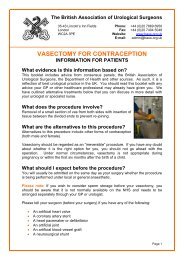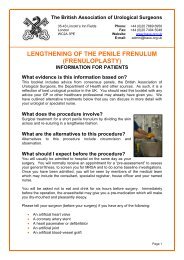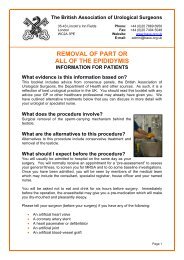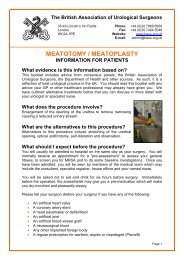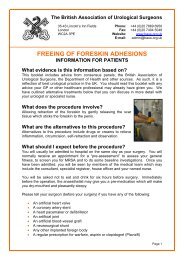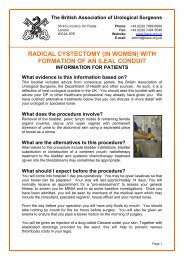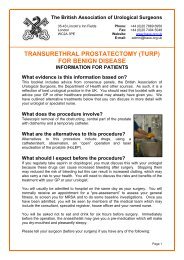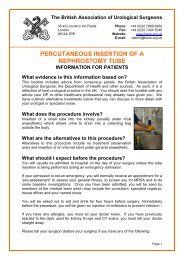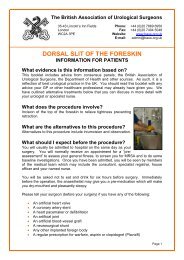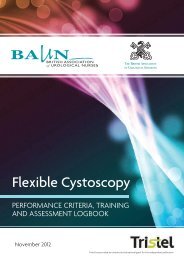MDT (multi-disciplinary team) guidance for managing prostate cancer
MDT (multi-disciplinary team) guidance for managing prostate cancer
MDT (multi-disciplinary team) guidance for managing prostate cancer
You also want an ePaper? Increase the reach of your titles
YUMPU automatically turns print PDFs into web optimized ePapers that Google loves.
The term locally advanced <strong>prostate</strong> <strong>cancer</strong> can be used to encompass a spectrum of disease profiles<br />
that may include any of the following:<br />
• Clinical stage T3, T4 or N1 <strong>cancer</strong>s without evidence of distant metastases (M0)<br />
• Clinical stages T1 and T2 (‘localised’) at diagnosis, where ‘high-risk’ features (PSA concentration<br />
≥20 ng/ml or Gleason grade ≥8) indicate the likelihood of extraprostatic invasion or clinically<br />
undetectable metastatic disease<br />
• Pathological stage pT2 or pT3 disease with ‘high-risk’ features due to upstaging from additional<br />
pathological in<strong>for</strong>mation after radical <strong>prostate</strong>ctomy<br />
Men with locally advanced or high-risk <strong>prostate</strong> <strong>cancer</strong> generally have a significant risk of disease<br />
progression and <strong>cancer</strong>-related death if left untreated. These patients present two specific challenges.<br />
There is a need <strong>for</strong> local control and also a need to treat any microscopic metastases likely to be<br />
present but undetectable until disease progression. The optimal treatment approach will often<br />
there<strong>for</strong>e utilise <strong>multi</strong>ple modalities. The exact combinations, timing and intensity of treatment<br />
continue to be strongly debated. Management decisions should be made after all treatments have<br />
been discussed by the <strong>MDT</strong> and the balance of benefits and side-effects of each therapy modality have<br />
been considered by the patient with regard to their own individual circumstances.<br />
Watchful waiting<br />
Overview<br />
• Data on the use of watchful waiting in locally advanced disease is sparse.<br />
• Two non-randomised studies concluded that immediate orchidectomy was not associated with a<br />
81, 82<br />
survival advantage compared with therapy delayed until metastatic progression.<br />
• A pooled analysis of data from 2 RCTs involving 1036 men with locally advanced disease not<br />
suitable <strong>for</strong> curative treatment (T2−T4) suggested no survival benefit <strong>for</strong> immediate versus<br />
delayed hormone therapy at 1, 5 or 10 years. 83<br />
Clinical evidence<br />
• Adolfsson et al. prospectively followed 50 patients with locally advanced <strong>prostate</strong> <strong>cancer</strong> who<br />
were only treated upon patient request or when they became symptomatic. All patients were<br />
followed-up <strong>for</strong> more than 144 months, or had died be<strong>for</strong>e that point. OS and DFS at 5, 10 and 12<br />
years was 68% and 90%, 34% and 74%, and 26% and 70%, respectively. 84<br />
31



